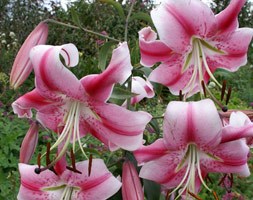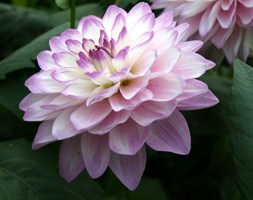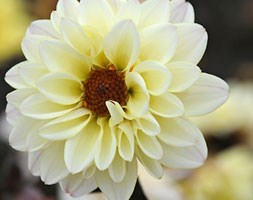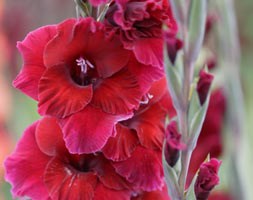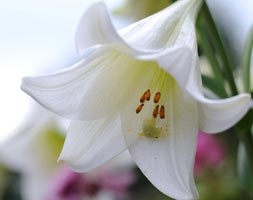Price reductions at Crocus
by Sarah - April 1st, 2014.Filed under: Crocus, Price Reductions.
Reduced price on items today at Crocus
Lilium ‘Anastasia’ (Skyscraper lily) was £3.99 now £1.99
Position: full sun with light dappled shade at its base Soil: fertile, reliably moist soil Rate of growth: fast-growing Flowering period: July Hardiness: fully hardy Hailed as a ‘super lily’, Anastasia is part of a select group of hybrids that have recently been bred by crossing oriental and trumpet lilies. The result is a plant that has inherited the best qualities of both its parents. This is a really tall lily that can reach up to 2.5m tall, and when well established, it can produce up to 25 flowers. The best news is that the breeding has not diminished the flowers scent, which is as heady and sweet as you would expect from a lily. Garden care: Lilies can be planted at any time from early autumn, to mid-spring. Planting in autumn often helps them settle in and become better established before they start to put on their new spring growth, but spring planting is a better option if your soil is heavy and wet during winter. Choose a sunny spot, preferably where the plant receives a little light shade at its base, and plant each bulb 15-20cm (6-8in) deep in a well-drained soil, enriched with well-rotted organic matter or leaf mould. Space them at approximately 30cm (12″) intervals and provide support before the flowers appear. Deadhead the faded blooms promptly and cut the dead stems back to ground level at the end of autumn.
Lilium ‘Chill Out’ (Skyscraper lily) was £2.99 now £1.99
Position: full sun with light dappled shade at its base Soil: fertile, reliably moist soil Rate of growth: fast-growing Flowering period: July Flower colour: white and yellow Hardiness: fully hardy The huge flowers of this gorgeous, scented lily are mainly white, but each petal has a broad lemon yellow blotch in the centre. A florists favourite, these flowers last well after being cut and look very impressive in arrangements. Garden care: Lilies can be planted at any time from early autumn, to mid-spring. Planting in autumn often helps them settle in and become better established before they start to put on their new spring growth, but spring planting is a better option if your soil is heavy and wet during winter. Choose a sunny spot, preferably where the plant receives a little light shade at its base, and plant each bulb 15-20cm (6-8in) deep in a well-drained soil, enriched with well-rotted organic matter or leaf mould. Space them at approximately 30cm (12″) intervals and provide support before the flowers appear. Deadhead the faded blooms promptly and cut the dead stems back to ground level at the end of autumn.
Dahlia ‘Blue Wish’ (dahlia tuber) was £3.49 now £2.49
Position: full sun Soil: fertile, humus-rich soil Rate of growth: average Flowering period: July to September Flower colour: lilac Other features: excellent cut-flowers Hardiness: half hardy (may need winter protection) As the flowers open, the purple tipped, white petals turn a more uniform shade of lilac. This creates a very pretty effect, and as the flowers are large, the overall picture is an impressive one. Their soft colouring mixes easily with many other shades, but is especially suited to bolder purples, white and all shades of pink. Garden care: Provide a high-nitrogen liquid feed each week in June, then a high-potash fertiliser each week from July to September. Once the first frosts of autumn have blackened the foliage, carefully lift and clean the tubers and allow them to dry naturally indoors. Place the dry tubers in a shallow tray, just covered with slightly moist potting compost, sand or vermiculite. Store in a frost-free place, checking frequently over the winter months.
Dahlia ‘Classic Swanlake’ (PBR) (dahlia tuber) was £3.49 now £2.49
Position: full sun Soil: fertile, humus-rich soil Rate of growth: average Flowering period: July to September Flower colour: Cream Other features: excellent cut-flowers Hardiness: half hardy (may need winter protection) A semi-double cultivar, with creamy white flowers that are held above the purple-flushed foliage on deep purple stems. The flowers, which appear from midsummer make long-lasting additions to the vase and will help attract bees to the garden. Garden care: Dahlia tubers can be planted outside after frost, or started off in pots under glass in late winter to early spring. Plant them horizontally approximately 12cm deep, making sure the ‘eyes’ are uppermost. Allow enough room between each tuber so the plants can grow and spread to their full size without being over-crowded. While in growth, provide a high-nitrogen liquid feed each week in June, then a high-potash fertiliser each week from July to September. Stake with canes or brushwood if it becomes necessary. In mild areas, leave them in situ over winter, but protect the crown with a generous layer of dry mulch. In colder areas, carefully lift and clean the tubers once the first frosts have blackened the foliage and allow them to dry naturally indoors. Then place the dry tubers in a shallow tray, just covered with slightly moist potting compost, sand or vermiculite and store in a frost-free place until planting out again.
Gladiolus ‘Plum Tart’ (gladioli bulbs) was £3.99 now £2.99
Position: full sun Soil: moist, well-drained soil Rate of growth: average Flowering period: July to September Flower colour: magenta Other features: excellent cut-flowers Hardiness: half hardy (will need winter protection) Perfect for adding colour to the late summer border, the majestic spires of this stunning perennial open from the base to reveal large, bright magenta coloured flowers, which have a soft velvety texture. Plant them in drifts through the herbaceous or cottage border, interspersing them with rich purple of soft pink coloured flowers. They also look spectacular when planted near silver foliage. Sought after by florists, the flowerspikes make spectacular additions to a large vase. Garden care: Plant corms 10-15cm (4-6in) deep and 25cm apart on a bed of sharp sand to aid drainage. In frost-prone areas, lift them when the leaves turn yellow-brown, dip the corms in fungicide and store in a dry, frost-free place over winter
Begonia mixed doubles (begonia bulbs) was £3.99 now £2.99
Position: full sun to partial shade Soil: any well-drained soil Rate of growth: average to fast Flowering period: June to October Flower colour: mixed Hardiness: tender, so store frost free over winter Bulb Size: 4-6cm Begonias are valued for their showy flowers, which appear for a very long period from early summer. They are one of the best bedding plants for areas of partial shade, as a lack of direct sun all day does not seem to have any significant impact on their ability to produce an abundance of flowers. The tubers (bulbs) in this fab collection will produce plants that flower in an array of bright colours, which will liven up the summer garden. Dot them around the front of the border, or cram your pots and window boxes with them. Garden care: Pot up in early spring when the growth can be seen emerging from the tubers. Begonias are tender so must be protected by frosts, however you can pot them up and grow them on under glass from January onwards. The indented side of the tuber is the top, and this should just be covered by a fine layer of compost. Water well and keep them in a bright, warm spot, watering again only when the soil becomes quite dry. Once they are actively growing they can be watered more regularly, especially those growing in sunnier positions, but make sure that the compost or soil is never overly wet or waterlogged. During the growing season they can be fed with a balanced liquid fertiliser. Begonias grown in the ground should be lifted before the first hard frosts and left to die back before being stored in a well ventilated, dry place over the winter. Container-grown plants should be brought under cover during winter and ‘potted on’ into a slightly larger container each year in spring.
Lilium regale ‘Album’ (lily) was £3.99 now £2.99
Position: full sun Soil: well-drained, including chalk, enriched with leaf mould or a loam-based potting compost such as John Innes no. 2 Rate of growth: average Flowering period: July Hardiness: fully hardy Bulb Size: 20/22 An incredibly popular variety with large, almost pure white trumpets with orange anthers. This is a form of Lilium regale, which does not have the pink flush to the outside of the petals, but it has retained every ounce of the sumptuously strong scent of its parent. A great choice for white borders, and looks spectacular at night when the flowers really seem to glow. Be warned, lilies are susceptible to a range of pests and diseases, including lily beetle, and as such can be high maintenance and may need replacing regularly. Garden care: Lilies can be planted at any time from early autumn, to mid-spring. Planting in autumn often helps them settle in and become better established before they start to put on their new spring growth, but spring planting is a better option if your soil is heavy and wet during winter. Choose a sunny spot, preferably where the plant receives a little light shade at its base, and plant each bulb 15-20cm (6-8in) deep in a well-drained soil, enriched with well-rotted organic matter or leaf mould. Space them at approximately 30cm (12″) intervals and provide support before the flowers appear. Deadhead the faded blooms promptly and cut the dead stems back to ground level at the end of autumn.
Lilium ‘Hotline’ (Skyscraper lily) was £3.99 now £2.99
Position: full sun with light dappled shade at its base Soil: fertile, reliably moist soil Rate of growth: fast-growing Flowering period: July Flower colour: pink and white Hardiness: fully hardy A magnificent lily with nice scent has creamy-white petals each of which is edged with a soft pink. It is easy to mix with a wide range of other colours in the garden. Garden care: Lilies can be planted at any time from early autumn, to mid-spring. Planting in autumn often helps them settle in and become better established before they start to put on their new spring growth, but spring planting is a better option if your soil is heavy and wet during winter. Choose a sunny spot, preferably where the plant receives a little light shade at its base, and plant each bulb 15-20cm (6-8in) deep in a well-drained soil, enriched with well-rotted organic matter or leaf mould. Space them at approximately 30cm (12″) intervals and provide support before the flowers appear. Deadhead the faded blooms promptly and cut the dead stems back to ground level at the end of autumn.
Lilium longiflorum ‘White Heaven’ (PBR) (Easter lily bulbs) was £3.99 now £2.99
Position: full sun or partial shade Soil: well-drained soil Rate of growth: fast-growing Flowering period: June to July Flower colour: white Other features: will tolerate chalky soil Hardiness: fully hardy Bulb Size: 14-16cm Big, deliciously scented, white flowers form in open clusters at the top of the upright stems in midsummer. These wonderfully showy flowers look brilliant in the border, but also work well in large, deep pots and containers. Make sure they are planted near a path, seating area or entranceway, so you can enjoy their heady perfume each time you pass. The flowers will also last well after being cut, so make sure you plant some extras for the vase. Garden care: Lilies can be planted at any time from early autumn, to mid-spring. Planting in autumn often helps them settle in and become better established before they start to put on their new spring growth, but spring planting is a better option if your soil is heavy and wet during winter. Choose a sunny spot, preferably where the plant receives a little light shade at its base, and plant each bulb 15-20cm (6-8in) deep in a well-drained soil, enriched with well-rotted organic matter or leaf mould. Space them at approximately 30cm (12″) intervals and provide support before the flowers appear. Deadhead the faded blooms promptly and cut the dead stems back to ground level at the end of autumn.







